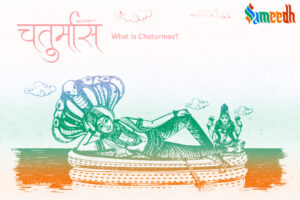Chaturmas, also known as Chaturmasya, is a sacred period of four months in Hinduism. It typically begins in the month of Ashadha (June/July) and concludes in the month of Kartik (October/November), corresponding to the rainy season in the Indian subcontinent. The term “Chaturmas” literally means “four months” in Sanskrit.

Chaturmas begins on Ashadha Purnima, which is the full moon day in the Hindu lunar month of Ashadha (typically falling in June or July). Ashadha Purnima marks the beginning of Chaturmas, the four-month period considered highly auspicious for religious observances, spiritual practices, and austerity in Hinduism. It sets the tone for devotees to embark on a period of heightened devotion, self-discipline, and introspection.
Ashadha Purnima is also known as Guru Purnima, a day dedicated to honoring and expressing gratitude to one’s spiritual teachers (gurus). The initiation of Chaturmas on this auspicious day underscores the importance of spiritual guidance and instruction in the lives of devotees. It emphasizes the role of gurus in imparting wisdom, guiding disciples on the spiritual path, and facilitating their spiritual growth during the sacred period of Chaturmas.
Chaturmas is particularly significant for followers of Vaishnavism (devotees of Lord Vishnu), as it is believed to be the period when Lord Vishnu rests in the cosmic ocean on the serpent Shesh. Therefore, it is customary for Vaishnavites to observe additional religious practices and restrictions during this time.
The Chaturmasa period holds significant mythological importance in Hinduism, embodying various narratives and symbolisms that highlight themes of spirituality, austerity, and divine grace. While Chaturmasa itself may not have a single specific mythological event associated with it, several mythological narratives and beliefs contribute to its significance:
- Lord Vishnu’s Cosmic Sleep (Yoga Nidra): One of the prominent mythological beliefs associated with Chaturmasa is that Lord Vishnu enters a state of cosmic sleep (Yoga Nidra) on the serpent Shesh in the ocean of milk during this period. This symbolic act represents the divine cycle of creation, preservation, and dissolution, with Vishnu resting before awakening to restore balance and order to the universe.
- Churning of the Ocean (Samudra Manthan): The churning of the ocean by the gods (Devs) and demons (Asurs) to obtain the nectar of immortality (Amrit) is a significant mythological event. While not specifically tied to Chaturmasa, this narrative underscores themes of perseverance, cooperation, and the quest for spiritual enlightenment—themes that resonate with the spirit of Chaturmasa.
- Births of Divine Beings: Several auspicious births and events associated with divine beings occur during Chaturmasa, such as the birth of Lord Krushna (Janmashtami), Lord Ganesh (Ganesh Chaturthi), and Goddess Lakshmi (Varalakshmi Vratham). These events are celebrated with devotion and joy, symbolizing the divine blessings and grace that enrich the spiritual journey during Chaturmasa.
- Auspicious Time for Spiritual Practices: Chaturmas is considered an auspicious period for engaging in spiritual practices, such as meditation, yoga, prayer, and reading scriptures. It is believed that spiritual activities performed during this time yield greater merit and help devotees progress on their spiritual journey.
- Observance of Austerity: Chaturmas is a time for observing austerity and self-discipline. Many Hindus undertake vows (vrat) during this period, which may involve fasting, abstaining from certain types of food or activities, and practicing renunciation. Austerity is seen as a means of purifying the mind and body, cultivating self-control, and deepening one’s spiritual resolve.
- Pilgrimage and Religious Observances: Devotees often embark on pilgrimages to sacred sites, temples, and holy rivers during Chaturmas. Visiting these places of spiritual significance and performing religious rituals are believed to bestow blessings and spiritual merit. Temples and spiritual centers may also organize special events, discourses, and ceremonies during Chaturmas to facilitate spiritual growth and devotion.
- Propagation of Spiritual Knowledge: Chaturmas is a time when spiritual teachers and scholars engage in the dissemination of spiritual knowledge. Lectures, seminars, and discussions on scriptures, philosophy, and spirituality are commonly held during this period, providing devotees with opportunities for learning and intellectual enrichment.
- Cultural and Social Significance: Chaturmas is deeply ingrained in the cultural and social fabric of Hindu society. It serves as a time for family gatherings, community events, and religious festivals. Through shared religious observances and collective acts of devotion, Chaturmas fosters a sense of unity, solidarity, and cultural continuity among Hindus.
Overall, Chaturmas embodies the spirit of spiritual renewal, self-discipline, and devotion in Hinduism. It provides devotees with a sacred time to deepen their connection with the divine, seek spiritual growth, and reaffirm their commitment to righteous living.
